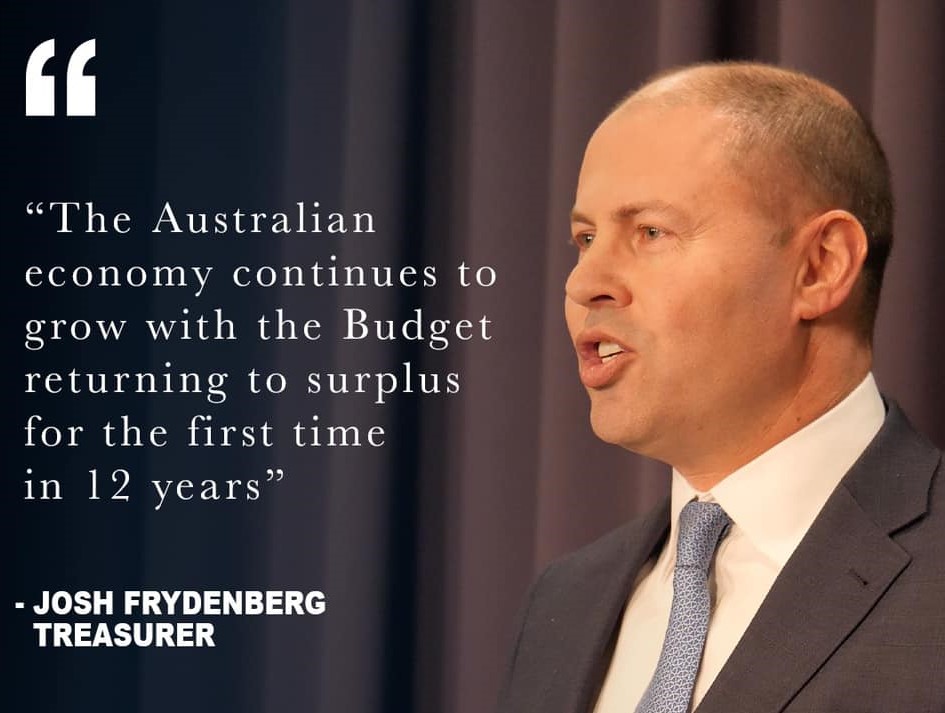Workers hoping for a pay rise as their Christmas present are unlikely to find anything in their stocking as the Australian government revised down its forecasts for economic and wages growth in its mid-year economic update.
Treasurer Josh Frydenberg and Finance Minister Mathias Cormann released the Mid-Year Economic and Fiscal Outlook (MYEFO) – the government’s end of year report updating April’s Budget figures – on Monday.
Wage growth forecasts were cut half a per cent, from 2.75 per cent this financial year to 2.25 per cent. The drop is more dramatic next year, down from 3.25 per cent to 2.5 per cent. The unemployment is up marginally, from 5.2 per cent to 5.25 per cent for this year and financial year (FY) 2021.
The Finance Minister was keen to emphasise that while wages growth is low, it remains above the rate of inflation, meaning wages are increasing in real terms.
With jobs growth predicted to be “moderate” and the “natural rate” of 5 per cent unemployment not due to return until the 2021-2022 financial year, that means any potential for wages growth above 3 per cent is also pushed back until 2022.
Gross domestic product (GDP) for the current year was downgraded half a percent to 2.25 per cent, but treasury remains upbeat about next financial year, leaving growth a 2.75 per cent – the figure it also had for this year and Treasury is hoping growth will return to the trend level in FY23
Nominal GDP, the monetary value of all the goods and services the nation produces, remained unchanged from April’s budget estimate of 3.25 per cent, but plummets 1.5 per cent in FY21, from 3.75 per cent to 2.25 per cent.
The MYEFO statement says budget surpluses are expected to continue to build to over 1 per cent of GDP in the medium term.
Spending growth is just 1.3 per cent average annual real growth in spending over the forward estimates period and payments as a share of GDP are at 24.5 per cent in 2019-20 falling to 24.4 percent by 2022-23, below the 30-year average.
The government’s tax-to-GDP ratio remains below its self-imposed cap of 23.9 per cent.
While the Morrison government has clung onto its pledge to keep the budget in surplus this financial year, slowing economic growth, and reduced GST revenue has wiped $2.1 million from the FY20 surplus, which is now forecast to be $5 billion.
The last federal budget surplus was in 2007-08, spanning the handover from the Howard government to Kevin Rudd
The reductions escalate over the four-year forward estimates, with the FY21 surplus down $4.9 billion to $6.1 billion and FY22 plunging $9.4 billion to an $8.4 billion surplus. In total, it’s a $21.6 billion reduction over four years. Nearly half of that figure is a $9.9 billion drop in GST revenue from the states and territories over the four years.
The budget is still predicted to deliver surpluses of $23.5 billion over that time.
Low interest rates and high export prices help
Low interest rates globally have helped the budget with the interest bill on current government borrowing expected to be $3.8 billion lower that originally predicted, and the other good news for the Treasurer is high iron ore prices.
Treasury budgeted for iron ore to be worth US$55 a tonne. It currently sits at $85 a tonne, delivering extra revenue to government coffers. The impact of higher prices is dramatic. The MYEFO calculations reveal US$10 per tonne above the $55 estimate adds $1.2 billion to the budget’s underlying cash balance this financial year, and more than three times that figure next year.
Falls in revenue from taxes on superannuation, company profits and employee income also hit the budget bottom line. The combined drop in revenue to the government over four years is $32.6 billion.
And while Monday’s update adds recent announcements to expenditure, including $537 million for aged care and $550 million for drought assistance, overall, government spending is reduced $1.4 billion this financial year and $11.5 billion over four years.
The economic slowdown has forced the Morrison government to give up on its plan to eliminate net debt by 2030. Net debt is predicted to be 1.8 per cent of GDP in 2030, rather than the budget’s zero forecast.
Treasurer Josh Frydenberg also revealed the Intergenerational Report due in March and released every five years, will be delayed until July and after the budget




























Trending